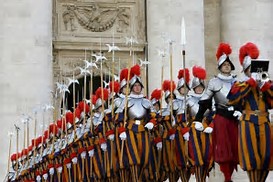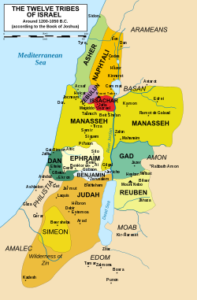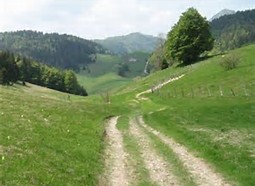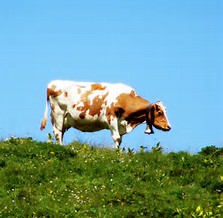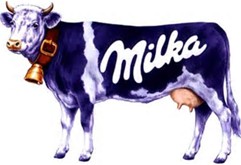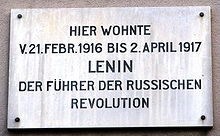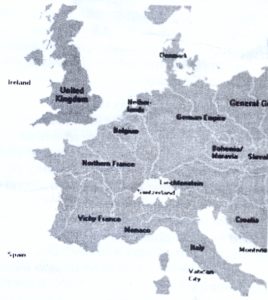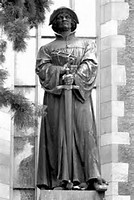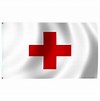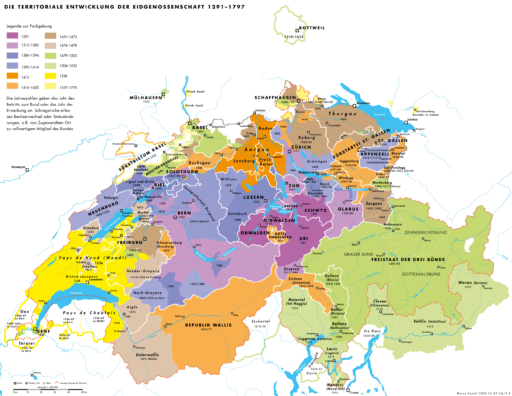TEN PROPHETIC CLUES CONCERNING GAD-SWITZERLAND
Holland
There is no direct history connecting the tribe of Gad to the Swiss people. We are talking about one of the lost tribes. The Caucasian population comes from various backgrounds. One can compare this with Jewry. The Jewish people have known many proselytes, yet, there has been a core of the tribe of Judah (and some of Levi & Benjamin) over the past 2500 years. The core passes on characteristics and genes to the periphery. Looking at ‘prophetic clues’, one has to conclude, that a core of the tribe of Gad once found its way to Celtic Switzerland. This core passed on its characteristics and genes to the influx of others.
The Celtic tribe of the Helvetii established themselves on the Swiss plateau between the Jura and the Alps. About 80% of all Swiss live on this plateau. In the east the Germanic Alemanni mixed with the Helvetii and in the west the Helvetii were dominated by the Germanic Burgundians. In the east the Germanic tongue dominated and in the west the Burgundi adopted the language of the romanized Helvetic Celts, which would evolve into French. As Switzerland was part of the Roman Empire, the Helvetii had lost their Celtic tongue. I believe the German and French speaking Swiss are from the tribe of Gad. There are many ‘prophetic clues’ between Gad and the Swiss. The more fulfilled prophetic clues we find, the stronger our case. What follows is not historic proof, but proof by revelation.
Ist Clue: Gad: fortune/happiness
When Leah saw that she had left off bearing, she took Zilpah her handmaid, and gave her to Jacob to wife. And Zilpah, Leah’s handmaid, bare Jacob a son. And Leah said, FORTUNATE! and she called his name GAD (Gen 30:9-11 , ASV, American Standard Version ; KJV throughout, unless mentioned otherwise).
And Leah said, It HAS GONE WELL for me: and she gave him the name Gad (Gen 30: 11, BBE, Bible in Basic English).
Lea dit : Quel BONHEUR [HAPPINESS] ! Et elle l’appela du nom de Gad (Gen 30: 11, LSG, Louis Segond).
There are two etymologies for the name Gad. In the first place it means fortune or happiness. There was a god of good fortune, whose name was Gad (Isa 65:11, Fortune in ASV; Gad in NKJV & Hebrew).
Leah said: Fortune (or Happiness) has come, and she named him Fort une (or Happiness) (Gad). Happiness or Fortune is of course more applicable to Switzerland than to any other country in the world. Whether it is because of cattle, cheese, clocks, watches, mercenaries, banks, international organisations, tourism or other things, the fact remains that Switzerland has been in the top ten of the most affluent countries over the past two centuries.
The ‘Swiss bank secrecy’ led to an all time record of amassed fortune in this country, Wikipedia: Currently an estimated ONE-THIRD of all worldwide funds held outside their country of origin (sometimes called “offshore” funds) are kept in Switzerland. In 2001, Swiss banks managed US$2.6 trillion … By 2007 this figure has risen to roughly US$2. 7 trillion, a record. https://en.wikipedia.org/wiki/Banking_in _Switzerland
The Swiss Franc is the only modern currency covered for more than 100% of its value. One in every 25 Swiss says he’s a millionaire (according to the Swiss magazine Cash, 19-11-2004).
Switzerland (with its mountains) has given many people happiness . Many went there because of health problems and Switzerland has been a favourite tourist attraction for the past 150 years.
2nd Clue: Gad, a troop, a gang, an army
And Leah said, A TROOP cometh: and she called his name Gad (Gen 30:11).
Genesis 49:19 Gad /gad], a TROOP [g’dud] shall OVERCOME [y’gudnu] him: but he shall OVERCOME [yagud] at the last. (Genesis 49:19).
Gad, an ARMY will come against him, but he will come down on them in their flight (Gen 49: 19, BBE) .
And the children of Reuben, and the children of Gad, and half the tribe of Manasseh, passed over ARMED BEFORE the children of Israel, as Moses spake unto them. (Josh 4:12).
And of the Gadites there separated themselves unto David into the hold to the wilderness MEN OF MIGHT, and MEN OF WAR fit for the battle, that could handle shield and buckler, whose faces were like the faces of LIONS, and were as swift as the roes upon the mountains; Ezer the first, Obadiah the second, Eliab the third … Machbanai the eleventh. These were of the sons of Gad, CAPTAINS of the HOST: one of the least was over an hundred, and the greatest over a thousand. These are they that went over Jordan in the first month, when it had overflown all his banks; and they put to flight all them of the valleys, both toward the east, and toward the west (1 Chron 12:8-14) .
The second etymological explanation of Gad is troop, gang or army. This explanation fits Jacob’s blessing better: Gad [gad], a TROOP [g’dud] shall OVERCOME [y’gudnu] him: but he shall OVERCOME [yagud] at the last (Gen 49:19). Four times a conjugation of Gad can be found in this verse: Gad g’dud j’gudnu, vehu jagud akev.
Gad’s emblem is a tent or a group of tents. The town Machanaim was in the tribal area of Gad. Machanaim means double camp or two camps.
A large people’s army
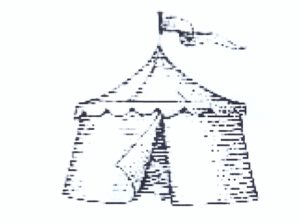 This military aspect of Gad can be found back among the Swiss. The Swiss maintain an armed neutrality. That is why Switzerland has a large people’s army. One could say: Switzerland does not have an army, Switzerland is an army. Switzerland is one huge army camp. At the age of 20 Swiss men are adult, eligible to vote and go into the army. After a short training, soldiers will be regularly called up. The structure of the Swiss militia system stipulates that the soldiers keep their own personal equipment, including all personally assigned weapons, at home (until 2007 this also included ammunition). Because of this the Swiss army can be mobilised faster than any other army. The Swiss army is large, modern, well trained and well equipped
This military aspect of Gad can be found back among the Swiss. The Swiss maintain an armed neutrality. That is why Switzerland has a large people’s army. One could say: Switzerland does not have an army, Switzerland is an army. Switzerland is one huge army camp. At the age of 20 Swiss men are adult, eligible to vote and go into the army. After a short training, soldiers will be regularly called up. The structure of the Swiss militia system stipulates that the soldiers keep their own personal equipment, including all personally assigned weapons, at home (until 2007 this also included ammunition). Because of this the Swiss army can be mobilised faster than any other army. The Swiss army is large, modern, well trained and well equipped
In a 2003 referendum the Swiss voted to reduce the army from 400,000 to 220,000 men. In WW I the Swiss mobilised 300,000 troops to make sure that the warring factions did not enter Switzerland. The Swiss were able to mobilise 800,000 in 1940 at WW II. For comparison: Adolf Hitler had 1 ,5 million troops to attack the USSR. Hitler left the Swiss alone, even after they shot down some of his planes in 1940.
Switzerland has one of the biggest and most expensive armies of Europe. Per capita Switzerland has the biggest army in the world, after the State of Israel.
CH – Confoederatio Helvetica
Gad is a gang, a troop.This can also be found back in the structure of the state. The Swiss cantons (‘states’) grew from a confederacy into a federal state : Confoederatio Helvetica. Until 1848 each canton had its own army. Gad is a gang, a troop, of cantons.
3rd Clue: Gad, Mercenaries & (Swiss) Guards
And of Gad [Moses] said, “Blessed be he who enlarges Gad! Gad couches LIKE A LION, HE TEARS THE ARM, AND THE CROWN of the head (Deut 33:20, RSV, Revised Standard Version) .
And of the GADITES there separated themselves unto David …MEN OF MIGHT, and MEN OF WAR fit for the BATTLE, that could handle SHIELD and BUCKLER, whose faces were like the faces of lions… These were of the sons of Gad, CAPTAINS of the HOST: one of the least was over an hundred, and the greatest over a thousand (I Chron 12:8-14).
From Rabbinical literature : Because of his GREAT STRENGTH [Gad] was not presented by Joseph to Pharaoh, lest the latter should appoint him one of his GUARDS (Gen. R. xcv. 4) (Jewish Encyclopedia).
Acharit haYamim
Jacob ‘s prophecies concerning the tribes are written down in Genesis 49. Verse 1 states that these are for the last days, ‘acharit haYamim ‘, which is normally translated, ‘in the latter days ‘ in the prophets. Personally I consider the last 500 years before the return of Christ as ‘the latter days ‘.
Gad [gad], a troop [g’dud] shall press [y’gudnu] upon him; But he shall press [yagud] upon their heel (Gen 49:19).
The Swiss fought the powerful Hapsburgs succesfully like lions: Gad couches like a lion, he tears the arm, and the crown of the head [the Hapsburgs and Burgundians] (Dt 33:20).
Mercenaries – Reislaufen
According to the Jewish Encyclopedia (1906) the tribe of Gad was a militaristic tribe. The name Gad has two etymological meanings: ‘luck, fortune’ and ‘troop’. From 1500 to 1850 many Swis made their fortune by hiring themselves out in gangs or troops to European kings and their wars. In 350 years’ time about 2 million Swiss have served as mercenary.
Wikipedia: Swiss Mercenaries
Wikipedia: Swiss mercenaries (Reislaufer) were valued throughout Late Medieval Europe for the power of their determined mass attack in deep columns with the pike and halberd. Hiring them was made even more attractive because entire ready-made Swiss mercenary contingents could be obtained by simply contracting with their local governments, the various Swiss cantons-the cantons had a form of militia system in which the soldiers were bound to serve and were trained and equipped to do so. Some Swiss also hired themselves out individually or in small bands.
… The young men who went off to fight, and sometimes die, in foreign service had several incentives-limited economic options in the still largely rural cantons; adventure; pride in the reputation of the Swiss as soldiers; and finally what military historian Sir Charles Oman describes as a pure love of combat and war-fighting in and of itself, forged by two centuries of conflict [with the Hapsburgs].
Papal Guard
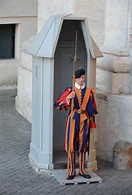 Kings and other princes acquired Swiss mercenaries since the late Middle Ages. These men were good soldiers and were loyal to their (paying) master and had no bond with the (often rebellious) population. A Swiss guard was acquired for the pope and the king of France. The House of Orange in the Netherlands had a Swiss guard too. The Swiss were loyal as long as they were paid. Today there is only one Swiss Guard left, the Papal Guard of Vatican City.
Kings and other princes acquired Swiss mercenaries since the late Middle Ages. These men were good soldiers and were loyal to their (paying) master and had no bond with the (often rebellious) population. A Swiss guard was acquired for the pope and the king of France. The House of Orange in the Netherlands had a Swiss guard too. The Swiss were loyal as long as they were paid. Today there is only one Swiss Guard left, the Papal Guard of Vatican City.
4th Clue: Gad lived in the mountains of Gilead
So he [Jacob] left in a hurry with all that belonged to him. He crossed the Euphrates River and went toward the MOUNTAINS of Gilead … Laban caught up with him in the MOUNTAINS of Gilead … When Laban finally caught up with Jacob, Jacob had put up his tents in the MOUNTAINS. So Laban and his relatives put up their tents in the MOUNTAINS of Gilead (Gen 31:21-25, GWV).
And some of the Hebrews went over Jordan to the land of Gad and Gilead. As for Saul, he was yet in Gilgal … (I Sam 13:7).
Gilead [ = tribe of Gad here] abode beyond Jordan … (Judg 5:17).
Then let them which are in Judaea flee to the MOUNTAINS … [ to the MOUNTAINS of Gilead according to the NIV Study Bible] (Lk 21 :21).
Gad lived in Gilead (Gil’ad)
Gad lived in the mountains of Gilead, the mountains of present day Jordan. Seen from the level of the River Jordan the Gil’ad mountains are 1500m high. The tribe of Gad used to live in the highest part of the Israelite nation. Just like the Swiss live in the highest part of Europe. Switzerland is a landlocked country and so was the tribal area of Gad.
Wikipedia: Gilead is also used to refer to the mountainous land extending north and south of Jabbok.
Flee to the mountains …
In his endtime speech Jesus advised the inhabitants of Jerusalem to flee to the mountains : And when ye shall see Jerusalem compassed with armies, then know that the desolation thereof is nigh. Then let them which are in Judaea flee to the mountains; and let them which are in the midst of it depart out; and let not them that are in the countries enter thereinto (Lk 21:20-21).
The mountains intended here, are not the hills of Samaria and Judea, but rather the mountains of Gilead, the tribal area of Gad.
There is an ante-typical fulfilment of that flight to the mountains of Gilead. At the beginning of the Jewish Revolt (66-70) the Messianic Community of Jerusalem fled to Pella (in Gilead), according to the historian Eusebius of Caesarea.
Switzerland – mountainous country
Switzerland is well known for its mountains. The Alps in the south and southeast (highest point, Monte Rosa, 4634m) and the Jura mountains in the west (highest point, Mont Tendre, 1678m).
5th Clue: Gad: much cattle
Now the children of Reuben and the children of GAD had A VERY GREAT MULTITUDE OF CATTLE: and when they saw the land of Jazer, and the land of Gilead, that, behold, the place was A PLACE FOR CATTLE. The children of GAD and the children of Reuben came and spake unto Moses … saying, Ataroth, and Dibon, and Jazer, and Nimrah, and Heshbon, and Elealeh, and Shebam, and Nebo, and Beon, even the country which the LORD smote before the congregation of Israel, is A LAND FOR CATTLE, and thy servants have CATTLE: Wherefore, said they, if we have found grace in thy sight, let this land be given unto thy servants for a possession, and bring us not over Jordan (Num 32: 1-5)
Our little ones, our wives, our flocks, and ALL OUR CATTLE, shall be there in the cities of Gilead: But thy servants will pass over, every man armed for war, before the LORD to battle, as my lord saith (Num 32:26-27).
The tribes of Ruben and Gad had much cattle and wanted to stay therefore in mountainous Gilead with its woods and meadows. Gad, Ruben and half of Manasseh ended up on the high plains of Jordan.
Switzerland – cattle
Switzerland is a country of mountains and valleys, and it often is very suited for cattle. After the summer the cattle are taken from the Alp meadows (transhumance). Some facts about Swiss cattle from:
https://en.agriculture.ch/knowledge/animals/ : A variety of productive livestock reside on the farms in Switzerland: cattle, pigs, goats, sheep, horses, donkeys, mules, fallow-deer, chicken, turkey, ducks, geese, rabbits and bees and for a couple of years now, even lamas, ostrich, bison and highland cattle. Swiss agriculture could hardly remain viable without the livestock industry . More than two-thirds of the turnover in agriculture is based on the production of milk, meat, eggs and other animals products.
From the same site Swiss farmers welcome you: Cattle account for almost half of the proceeds of Swiss agriculture. All in all, farmers keep astock of somewhat less than 1.7 million cattle: dairy cows, heifers, calves, bulls, breeding bulls and oxen. Simmentaler and Brown cows are themost popular breeds in Switzerland. Due to better performance, the number of dairy cows has diminished drastically over the past years. Since the 1970’s, nurse and suckling cows have become more and more common in Switzerland.
Swiss cheese
Swiss cheeses are well-known. There is even a Wikipedia site with a list of Swiss cheeses.
Wikipedia: Switzerland is home to about 450 varieties of cheese. Cow ‘s milk is used in about 99 percent of the cheeses produced. The remaining share is made up of sheep milk and goat milk.
Cheese fondue
Wikipedia: The earliest known recipe for cheese fondue as we know it today comes from a 1699 book published in Zurich, under the name “Kase mit Wein zu kochen”, “to cook cheese withwine”. It calls for grated or cut-up cheese to be melted withwine, and for bread to be dipped in it. … The first known recipe for the modern cheese fondue under that name, with cheese and wine but no eggs, was published in 1875, and was already presented as a Swiss national dish. … Fondue was popularized as a Swiss national dish by the Swiss Cheese Union {Schweizerische Kaseunion) in the 1930s as away of increasing cheese consumption. … Fondue is now a symbol of Swiss unity.
Swiss Chocolate
Wikipedia : The 17th century saw the start of chocolate processed in Switzerland … In the second half of the 19th century Swiss Chocolate started to spread abroad. Closely linked to this was the invention of Milk Chocolate by Daniel Peter in Vevey and the invention of the conching by Rodolphe Lindt … From the 19th century until the First World War and throughout the Second World War the Swiss chocolate industry was very export-oriented … Today most Swiss chocolate is consumed by the Swiss themselves {54% in 2000}, and Switzerland has the highest per capita rate of chocolate consumption worldwide (11.6 kg {25.6 lbs.} per capita per annum). In 2004 148,270 tonnes of chocolate were produced in Switzerland. 53% of this was exported.
Cattle – milk – chocolate – happiness …
6th Clue: Gad: place of refuge
And Moses gave inheritance unto the tribe of Gad, even unto the children of Gad according to their families. And their border was Jazer, and all the cities of Gilead, and half the land of the children of Ammon … from MAHANAIM unto the border of Debir (Josh 13:24-26, KJ21).
And the Philistines mustered to fight with Israel, [3000] chariots, and 6000 horsemen, and troops like the sand on the seashore in multitude … When the men of Israel saw that they were in straits (for the people were hard pressed) , the people hid themselves in caves and in holes and in rocks and in tombs and in cisterns, or crossed the fords of the Jordan to the LAND of GAD and GILEAD … (I Sam 13: 5-7, RSV).
But Abner the son of Ner, captain of Saul’s host, took Jshbosheth the son of Saul, and brought him over to MAHANAIM; And made him king over Gilead… and over all Israel. … But the house of Judah followed David (2 Sam 2:8-10).
So Joab blew a trumpet, and all the people [of Judah] stood still, and pursued after Israel no more, neither fought they any more. And Abner and his men walked all that night through the plain, and passed over Jordan … and they came to MAHANAIM (2 Sam 2:28-29) .
Then David came to MAHANAIM. And Absalom crossed the Jordan with all the men of Israel (2 Sam 17:24, RSV).
“Get thee hence and turn thee [Elijah] eastward, and HIDE thyself by the Brook Cherith, that is before the Jordan (I Kings 17:3, KJ21).
Because of its mountains, rocks, clefts, brooks and caves the land of Gad is a natural area to flee to. The town Mahanaim on the Jabbok was in the land of Gad, in Gilead.
At the war of Saul against the Philistines many hid here; lshbosheth and Abner waged war against Joab and David from Mahanaim ; when Absalom took over the throne, his father David fled to Mahanaim.
Elijah, a Gadite, hid by the brook Cherith -Wadi al Yabis (the Wadi of Jabesh) – in the land of Gad. The Church of Jerusalem fled to Pella (also in the land of Gad) in 66 AD. The land of Gad is a perfect place of refuge (2 million Palestinians fled to Jordan in the 20th century).
Republic of Geneva
Geneva became an independant republic in the 16th century. Under John Calvin it became the centre of calvinism. Calvin fought for free access to Geneva for Protestant refugees. Geneva became a member of the Swiss Republic (Eidgenossenschaft) in 1815.
World War I
During World War I many people fled to Switzerland. Wikipedia: During the fighting, Switzerland became a haven for many politicians , artists, pacifists, and thinkers. Bern, Zurich, and Geneva became centers of debate and discussion. In Zurich two very different anti-war groups would bring lasting changes to the world, the Bolsheviks and the Dadaists.
World War II
Switzerland’s refugee record during WW II is not faultless, yet many were able to flee to the Swiss Republic. Wikipedia: Over the course of the war, Switzerland interned 300,000 refugees. Of these, 104,000 were foreign troops … Therest were foreign civilians and were either interned or granted tolerance or residence permits by the cantonal authorities. Refugees were not allowed to hold jobs . Of the refugees, 60,000 were civilians escaping persecution by the Nazis. Ofthese, 26,000 to 27,000 were Jews. Between 10,000 and 24,000 Jewish civilian refugees were refused entry. Although Switzerland harboured more Jewish refugees than any other country, these refugees were refused entry on the grounds of already dwindling supplies. Of those refused entry, a Swiss government representative said, “Our little lifeboat is full.” At the beginning of the war, Switzerland had a Jewish population of between 18,000 and 28,000 and a total population of about 4 million. By the end of the war, there were over 115,000 refuge-seeking people of all categories in Switzerland, representing the maximum number of refugees at any one time.
Switzerland also acted as a refuge for Allied prisoners of war who escaped, including those from Oflag IV-C (Colditz).
7th Clue: Gad: uninvolved, neutral
And Moses said unto the children of GAD and to the children of Reuben, Shall your brethren go to war, and shall ye SIT HERE {in Gilead]? And wherefore discourage ye the heart of the children of Israel from going over into the land which the LORD hath given them? (Num 32:6-7).
GILEAD = [GAD] stayed beyond the Jordan … (Judg 5:17).
And he said unto the men of Succoth [town in GAD], “Give, I pray you, loaves of bread unto the people who follow me, for they are faint, and I am pursuing after Zebah and Zalmunna, kings of Midian.” And the princes of Succoth said, are the hands of Zebah and Zalmunna now in thine hand, that we should give bread unto thine army?” And Gideon said, “Therefore when the LORD hath delivered Zebah and Zalmunna into mine hand, then I will tear your flesh with the thorns of the wilderness and with briers.” And he went up thence to Penuel {another town in GAD] and spoke unto them likewise, and the men of Penuel answered him as the men of Succoth had answered him. And he spoke also unto the men of Penuel, saying, “When I come again in peace, I will break down this tower” (Judg 8:5-9, KJ21).
They said, “What one is there of the tribes of Israel who didn’t come up to Yahweh to Mizpah?” Behold, there came none to the camp from Jabesh Gilead [town in GAD] to the assembly. For when the people were numbered, behold, there were none of the inhabitants of Jabesh Gilead there (Judg 21 :8-9).
Gad – aloof, uninvolved
Gad or the towns in Gad often stayed uninvolved. To start with, Moses did not like that Gad and Reuben wanted to stay in Gilead. It was seen as a sign of rebellion or uninvolvedness. Later on in history the Transjordan tribes were the first to go in exile.
At the time of Deborah the Gadites did not send any men to help against Sisera (Judg 5:17). Gilead here means Gad, for Reuben and Manasseh (Machir) have already been mentioned .
When the judge Gideon asked the Gadites of Succoth and Penuel for bread and support against the Midianites , they refused and remained uninvolved, just as in the time of Deborah.
When called upon, the Gadites of Jabesh in Gad (Gilead) did not send men either, to avenge the corruption of the Benjamites of Gibeah.
Switzerland – neutral
At the Congress of Vienna (1815) the five major European powers recognized and guaranteed Switzerland ‘s neutrality. From that time onward Switzerland and neutrality are closely tied . Neutrality is Switzerland’s starting point for foreign policy.
From Wikipedia, Switzerland during the World Wars: During both World War Iand World War II, Switzerland managed to keep astance of armed neutrality, and was not involved militarily. However, precisely because of its neutral status, Switzerland was of considerable interest to all parties involved, as the scene for diplomacy, espionage, commerce, and as a safe haven for refugees
Following the declarations of war in late July 1914, on 1 August 1914 Switzerland mobilized its army; by August 7 the newly appointed general Ulrich Wille had about 220, 000 men under his command. By August 11 Wille had deployed much of the army along the Jura border with France, with smaller units deployed along the eastern and southern borders …
During the war Switzerland accepted 68,000 British, French and German wounded prisoners of war for recovery in mountain resorts. The wounded were transferred from prisoner of war camps unable to cope with the number of wounded and sat out the war in Switzerland. The transfer was agreed between the warring powers …
At the outbreak of World War II in 1939, Switzerland immediately began to mobilize for apossible invasion. The transition into wartime was smooth and caused less controversy than in 1914. The entire country was fully mobilized in only three days. Parliament quickly selected the 61 year-old career soldier Henri Guisan to be General. By 3 September 430,000 men of combat troops and 200,000 men of mandatory support services and 10, 000 women of the female support service had been mobilized
… Over the course of the war, detailed invasion plans were drawn up by the German military command, such as Operation Tannenbaum, but Switzerland was never attacked. Switzerland was able to remain independent through a combination of military deterrence, economic concessions to Germany, and good fortune …
Nazi Germany repeatedly violated Swiss airspace. During the Invasion of France, German aircraft violated Swiss airspace at least 197 times. In several air incidents, the Swiss shot down 11 Luftwaffe planes between 10 May 1940 and 17 June 1940. Germany protested diplomatically on 5 June 1940, and with a second note on 19 June 1940 which contained clear threats. Hitler was especially furious when he saw that German equipment was used to shoot down German pilots. He said they would respond “in another manner”. On 20 June 1940, the Swiss air force was ordered to stop intercepting planes violating Swiss airspace. Swiss fighters began instead to force intruding aircraft to land at Swiss airfields. Anti-aircraft units still operated. later, Hitler and Hermann Goring sent saboteurs to destroy Swiss airfields. However, the sabotage team was captured by the Swiss army before it could cause any damage. Skirmishes between German and Swiss troops took place in the northern border of Switzerland throughout the war …
From 1943 Switzerland stopped American and British aircraft, mainly bombers, overflying Switzerland during World War II: six by Swiss air force fighters and nine by flak cannons, and 36 airmen were killed. On 1 October 1943 the first American bomber was shot near Bad Ragaz: Only three men survived. The officers were interned in Davos, airmen in Adelboden . The representative of the US military intelligence in Bern, US military attache Barnwell Legge, instructed the soldiers not to flee, but the majority of the soldiers thought it was a diplomatic joke. Allied aircraft also intruded on Swiss airspace during the war, mostly Allied bombers returning from raids over Italy and Germany that had been damaged and whose crews preferred internment by the Swiss to becoming prisoners of war. Over a hundred Allied aircraft and their crews were interned ; ..
8th Clue: Gad: reformers
Now ELIJAH the TISHBITE, of TISHBE in GILEAD, said to Ahab … (1 Ki 17: I) [Tishbe, place in Gad].
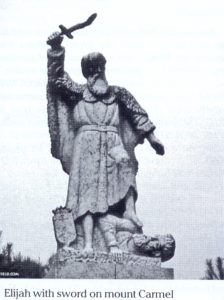 And Elijah came near to all the people, and said, “How long will you go limping with two diferent opinions? If the LORD is God, follow him; but if Baal, then follow him.” And the people did not answer him a word. Then Elijah said to the people, “I, even I only, am left a prophet of the LORD; but Baal’s prophets are 450 men. Let two bulls be given to us; and let them choose one bull for themselves, and cut it in pieces and lay it on the wood, but put no fire to it; and I will prepare the other bull and lay it on the wood, and put no fire to it. And you call on the name of your god and I will call on the name of the LORD; and the God who answers by fire, he is God.” And all the people answered, “It is well spoken.” … Then Elijah said to all the people, “Come near to me”; and all the people came near to him … And at the time of the offering of the oblation, Elijah the prophet came near and said, “O LORD, God of Abraham , Isaac, and Israel, let it be known this day that thou art God in Israel, and that I am thy servant, and that I have done all these things at thy word. Answer me, O LORD, answer me, that this people may know that thou, O LORD, art God, and that thou hast turned their hearts back.” Then the fire of the LORD fell, and consumed the burnt offering, and the wood, and the stones, and the dust, and licked up the water that was in the trench. And when all the people saw it, they fell on their faces; and they said, “The LORD, he is God; the LORD, he is God.” And Elijah said to them, “Seize the prophets of Baal; let not one of them escape.” And they seized them; and Elijah brought them down to the brook Kishon, and KILLED them there (I Ki 18:21-40, RSV) .
And Elijah came near to all the people, and said, “How long will you go limping with two diferent opinions? If the LORD is God, follow him; but if Baal, then follow him.” And the people did not answer him a word. Then Elijah said to the people, “I, even I only, am left a prophet of the LORD; but Baal’s prophets are 450 men. Let two bulls be given to us; and let them choose one bull for themselves, and cut it in pieces and lay it on the wood, but put no fire to it; and I will prepare the other bull and lay it on the wood, and put no fire to it. And you call on the name of your god and I will call on the name of the LORD; and the God who answers by fire, he is God.” And all the people answered, “It is well spoken.” … Then Elijah said to all the people, “Come near to me”; and all the people came near to him … And at the time of the offering of the oblation, Elijah the prophet came near and said, “O LORD, God of Abraham , Isaac, and Israel, let it be known this day that thou art God in Israel, and that I am thy servant, and that I have done all these things at thy word. Answer me, O LORD, answer me, that this people may know that thou, O LORD, art God, and that thou hast turned their hearts back.” Then the fire of the LORD fell, and consumed the burnt offering, and the wood, and the stones, and the dust, and licked up the water that was in the trench. And when all the people saw it, they fell on their faces; and they said, “The LORD, he is God; the LORD, he is God.” And Elijah said to them, “Seize the prophets of Baal; let not one of them escape.” And they seized them; and Elijah brought them down to the brook Kishon, and KILLED them there (I Ki 18:21-40, RSV) .
And Ahab told Jezebel all that Elijah had done, and also how he had SLAIN all the prophets with the SWORD (I Ki 19:1).
Elijah, the reformer
The Bible mentions seven times that Elijah was a Tishbite form Tishbe. Tishbe was a small place in the tribal area of Gad, past Jabesh, by the brook Cherith.
Elijah was a prophet, a reformer, in the northern kingdom, in the House of Israel. It is noteworthy that he is the only prophet of whom we know that he had killed hundreds of false prophets by the sword. Preaching the Word of the LORD and handling the sword were both practiced by him. Elijah is the best-known Gadite of the Old Testament.
Zwingli – Swiss (Protestant) Reformer
Huldrych Zwingli (1484 – 1531) was an important Swiss reformer and one of the leaders of the Swiss reformation, and of protestantism within Switzerland. Independently from Maarten Luther, Zwingli came to his reformist ideas concerning the Church. As priest of the Grossmi.inster-church in Zurich, Zwingli started doubting certain doctrines of the Roman Catholic Church. Zwingli always maintained that he did not know of Maarten Luther’s writings and that he started the Swiss reformation independently.
Zwingli was a proponent of armed struggle against the catholic cantons. He died in a battle against the catholics. His helmet has been taken as a trophy to Lucerne and can be seen in a museum there, together with his sword and battle-axe. Zwingli was a reformer – think of Elijah – and attacked his ‘false-prophets’ with both the Bible and the sword.
Heinrich Bullinger
Wikipedia: Heinrich Bullinger [8 July 1504 – 17 September 1575] was a Swiss reformer, the successor of Huldrych Zwingli as head of the Zurich church and pastor at Grossmiinster. A much less controversial figure than John Calvin or Martin Luther, his importance has long been underestimated; recent research shows that he was one of the most influential theologians of the Protestant Reformation in the 16th century.
The First Helvetic Confession, known also as the Second Confession of Basel, was drawn up at that city in 1536 by Heinrich Bullinger and Leo Jud … The Second Helvetic Confession … was written by Bullinger in 1562 and revised in 1564 as a private exercise.
Calvin – Geneva
Under the leadership of John Calvin, Geneva became the centre of the Calvinistic Reformation. Many flocked to Geneva for study and education, only to be sent out all over Europe to teach.
9th Clue: Gad: from hate to love
CH. 1 THE copy of the testament of Gad … And Joseph told our father that the sons of Zilpah and Bilhah were slaying the best of the flock and eating them against the judgement of Reuben and Judah … And regarding this matter I was wroth with Joseph until the day that he was sold …And the spirit of hatred was in me … I confess now my gin, my children, that oftentimes I wished to kill him, because I hated him from my heart. Moreover, I hated him yet more for his dreams … Beware, therefore, my children of hatred, for it worketh lawlessness even against the lord Himself … For the spirit of hatred worketh together with Satan, through hastiness of spirits, in all things to men’s death; but the spirit of love worketh together with the law of God in long-suffering unto the salvation of men. Hatred, therefore, is evil, for it constantly mateth with lying, speaking against the truth; and it maketh small things to be great, and causeth the light to be darkness, and calleth the sweet bitter, and teacheth slander, and kindleth wrath, and stirreth up war, and violence and all covetousness; it filleth the heart with evils and devilish poison. These things, therefore, I say to you from experience, my children, that ye may drive forth hatred, which is of the devil, and cleave to the love of God. Righteousness casteth out hatred, humility destroyeth envy … These things I learnt at last, after I had repented concerning Joseph … CH. 2. AND now, my children, I exhort you, love ye each one his brother, and put away hatred from your hearts, love one another in deed, and in word, and in the inclination of the soul. For in the presence of my father I spoke peaceably to Joseph; and when I had gone out, the spirit of hatred darkened my mind, and stirred up my soul to slay him. Love ye one another from the heart; and if a man sin against thee, speak peaceably to him, and in thy soul hold not guile; and if he repent and confess, forgive him (TESTAMENT of GAD).
The pseudo-epigraphic book Testament of the Twelve Patriarchs often gives us extra information about a certain patriarch and tribe. According to the Testament of Gad, Gad had been full of hatred towards Joseph. Gad warned his children against hatred, told of his experience and advised them to follow the way of love or charity.
Flag of the Red Cross
The change from hatred to charity nicely reflects Swiss history. Nearly 2 million Swiss have fought 350 years in the mercenary system (ca. 1500 – 1850), until this was forbidden by law (1859 Constitution). The Swiss Henri Dunant founded the Red Cross, the colours of neutral Switzerland were turned around. The army camps of Gad became in a way the refugee camps of the Red Cross, this time not for war, but for love and charity.
Henry Dunant – Red Cross
Wikipedia: Henry Dunant (Red Cross): Jean Henri Dunant (8 May 1828 -30 October 1910), also known as Henry Dunant, was the founder of the Red Cross, and the first recipient of the Nobel Peace Prize. The 1864 Geneva Convention was based on Dunant ‘s ideas. In 1901 he received the first Nobel Peace Prize together with Frederic Passy, making Dunant the first Swiss Nobel laureate.
Dunant was a Swiss businessman and social activist. During a business trip in 1859, he was witness to the aftermath of the Battle of Solferino in modern-day Italy. He recorded his memories and experiences in the book A Memory of Solferino which inspired the creation of the International Committee of the Red Cross (ICRC) in 1863.
10th Clue: Gad: oath/covenant on the mountain
So [Jacob] fled with all that he had; and he rose up, and passed over the River, and set his face toward the MOUNTAIN of Gilead [Gad territory] … And [Laban] … pursued after him seven days’ journey; and he overtook him in the MOUNTAIN of Gilead [Gad territory] … And Laban came up with Jacob. Now Jacob had pitched his tent in the MOUNTAIN: and Laban with his brethren encamped in the MOUNTAIN of Gilead [Gad territory] … And Laban answered … And now come, let us make a COVENANT, I and thou; and let it be for a WITNESS [Hebr.: ed] between me and thee. And Jacob took a STONE, and set it up for a PILLAR. And Jacob said unto his brethren, Gather STONES; and they took STONES, and made a HEAP: and they did eat there by the HEAP. And Laban called it Jegar-saha-dutha: but Jacob called it Gal’ed …And Laban said, This HEAP is WITNESS between me and thee this day. Therefore was the name of it called Gal’ed [Cf. Gil’ad] …And Laban said to Jacob, Behold this HEAP, and behold the PILLAR, which I have set betwixt me and thee. This HEAP be WITNESS, and the PILLAR be WITNESS, that I will not pass over this HEAP to thee, and that thou shalt not pass over this HEAP and this PILLAR unto me, for harm. The God of Abraham, and the God of Nahor, the God of their father, judge betwixt us. And Jacob SWARE by the Fear of his father Isaac. And Jacob offered asacrifice in the MOUNTAIN, and called his brethren to eat bread: and they did eat bread, and tarried all night in the MOUNTAIN (Genesis 31, ASV) .
The tribe of Gad lived in the Mountains of Gilead, or more correct Gil’ad. The area got its name from the covenant that Jacob and Laban made on a mountain there, confirmed by oath. Gal means stone or heap of stones and Ed means witness. Hence Gal-Ed is witness stone or stone of witness . Gal’ed has the same Hebrew letters as Gil’ad (Gilead).
‘Eidgenossenschaft’ (Confederation)
Wikipedia: Eidgenossenschaft. Eidgenossenschaft is a German word meaning confederation. The term literally translates as “oath fellowship”. An Eidgenossenschaft is a confederacy of equal partners, which can be individuals or groups such as states, formed by a pact sealed by a solemn oath.
Swiss Eidgenossenschaft
Development of the Swiss Eidgenossenschaft
Wikipedia: As a political term, it is used most often as asynonym for Switzerland, whose official German name is “Schweizerische Eidgenossenschaft “, usually translated as Swiss Confederation. The oath referred to is the Rutlischwur, the three men recorded as taking the oath on August 1, 1291 historiographic tradition are the Three Confederates (Drei Eidgenossen). An Eidgenosse (literally: comrade by oath) is a member of an Eidgenossenschaft , and is an expression for “Swiss citizen”. The related adjective, eidgenossisch, officially translated as Swiss federal, is used in the name of organisations , for example the ‘Eidgenossische Technische Hochschule ‘, Swiss Federal Institute of Technology. In a historical context, Eidgenossenschaft typically refers to the medieval Swiss Confederacy, which grew from the 13th to the 16th century in central Europe, persisted until 1798 and then evolved into a federal state in the 19th century.
The Swiss mountain state started with an oath by the three cantons Uri, Schwyz and Unterwalden on a mountain meadow. The tribe of Gad lived in Gil’ad (Gilead), named after the oath or covenant between Laban and Jacob (Gal’ed), also performed on a mountain.
September 2016, Gouda, Holland, Bert Otten


